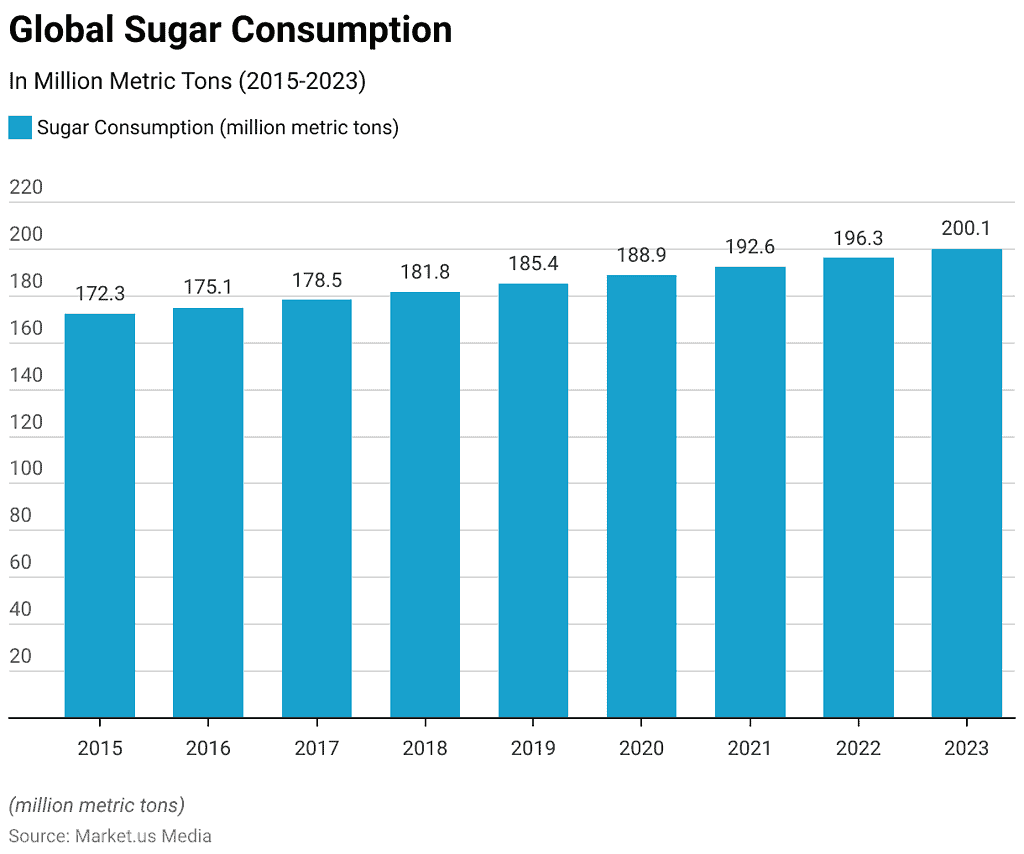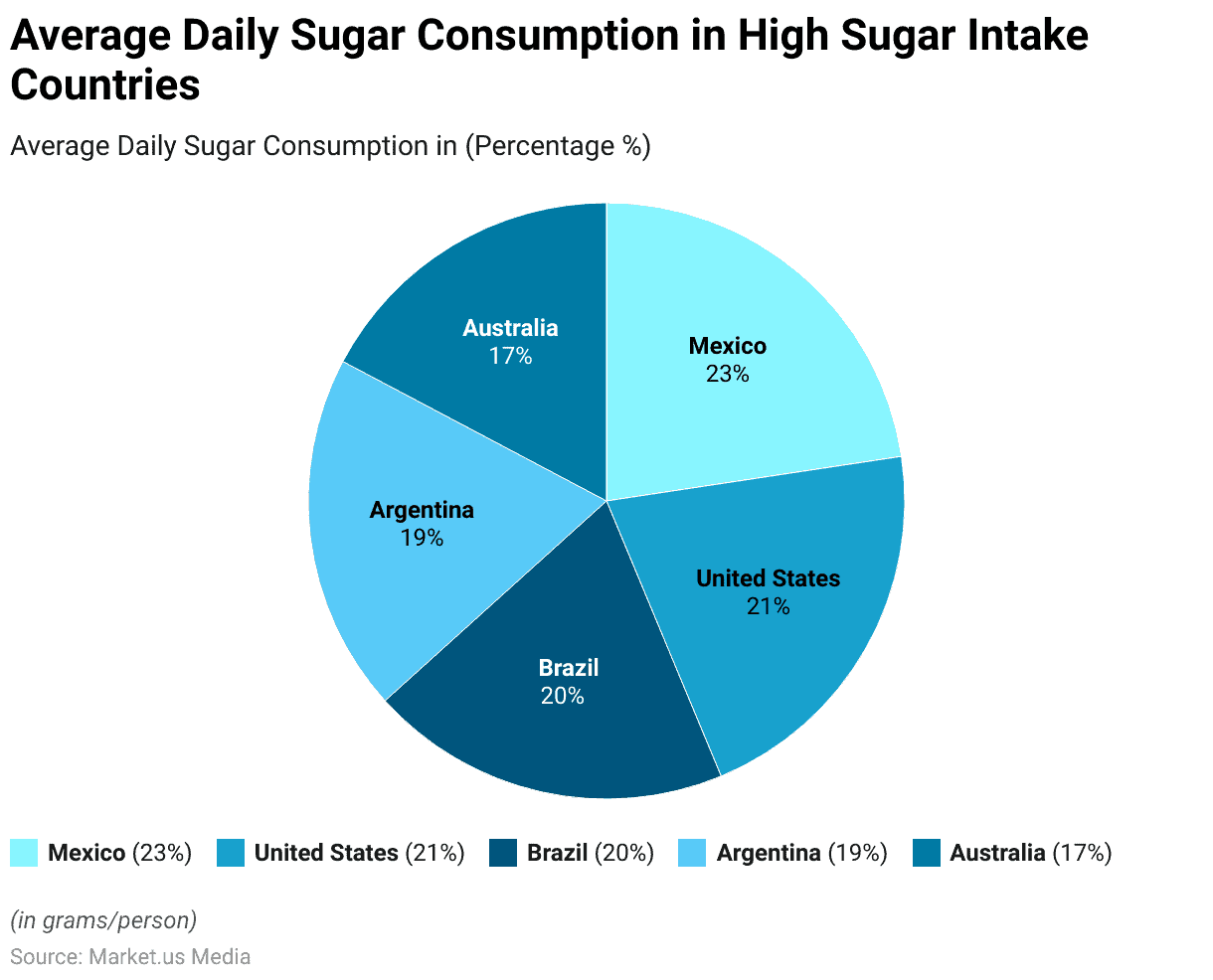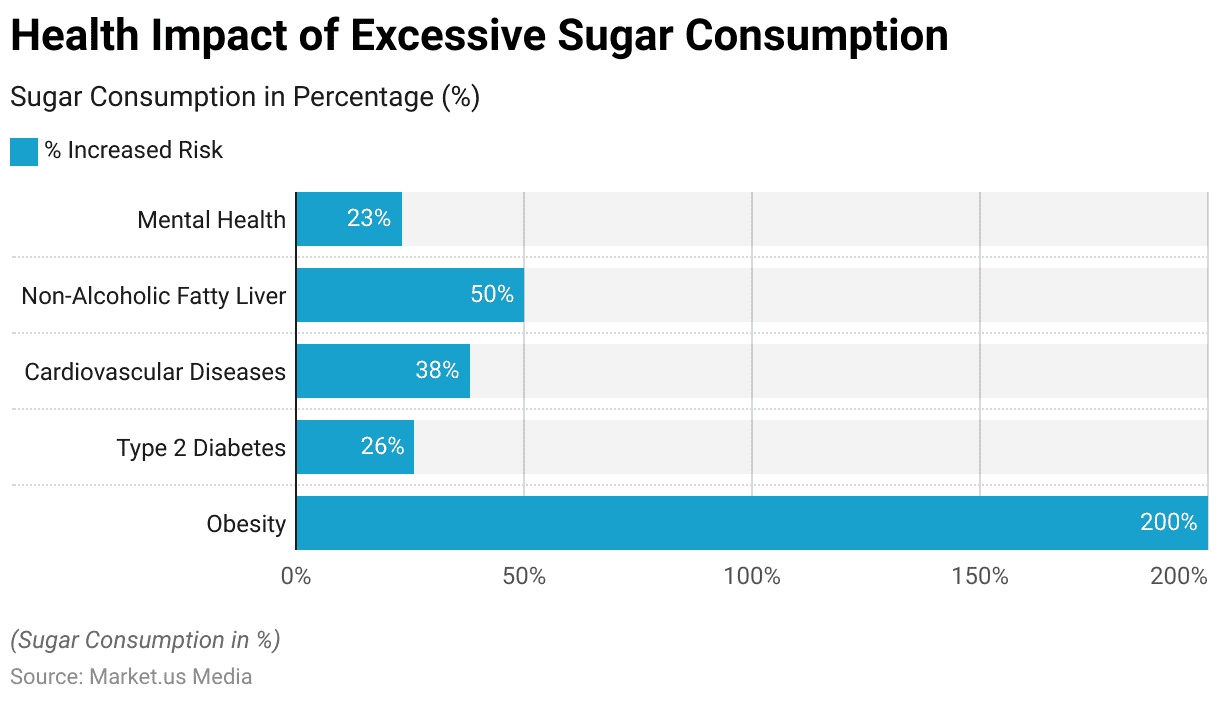According to Dietary Sugar Statistics, Dietary Sugar, also known as added sugar or free sugar, refers to the sugars that are added to foods and beverages during processing or preparation. These sugars are not naturally present in the food but are added to enhance flavor, texture, and palatability.
Dietary sugar is different from the sugars naturally found in whole foods like fruits, vegetables, and dairy products, which are accompanied by beneficial nutrients like fiber, vitamins, and minerals.
Table of Contents
Editor’s Choice
- Diabetic Food Market has the largest market share for diabetic foods held by dairy products, with a more than 25.0% revenue share.
- The global consumption of dietary sugar amounted to about 176 million metric tons in 2022/23 and is projected to increase to about 180.05 million metric tons by 2023/2024.
- The average American consumes around 17 teaspoons (71.14 grams) of added sugar per day.
- In the United Kingdom, teenagers and adults consume three times the recommended daily limit of added sugars.
- High sugar intake is linked to an increased risk of obesity and overweight, affecting over 650 million adults worldwide.
- Excessive sugar consumption is associated with a higher likelihood of developing type 2 diabetes, affecting approximately 422 million people globally.
- Consuming sugary beverages regularly increases the risk of heart disease by up to 20%.
- Dental caries (tooth decay) is the most prevalent diet-related disease, affecting almost half of the world’s population, primarily due to high sugar intake.
- Mexico has one of the highest sugar-sweetened beverage consumption rates, with an average of 163 liters per person per year.
Global Consumption of Sugar Key Statistics
- The global average sugar consumption per person per year is around 17 kilograms.
- Some countries have much higher sugar consumption levels, with some exceeding 40 kilograms per person per year.
- Excessive sugar intake is associated with an increased risk of obesity, diabetes, and cardiovascular diseases worldwide.
- Processed foods and sugary beverages are major contributors to the rising sugar intake in many countries.
- Several countries have implemented sugar taxes to reduce sugar consumption and promote healthier diets.
- High sugar consumption is particularly concerning among children, contributing to rising rates of childhood obesity and dental cavities worldwide.
- The prevalence of non-communicable diseases (NCDs), such as diabetes and heart disease, is closely linked to high sugar intake on a global scale.
- The World Health Organization recommends reducing daily sugar intake to less than 10% of total energy intake and suggests further health benefits from limiting it to 5% or less.
- In 2021, the global consumption of sugar was reported to be 192.6 million metric tons.
- This figure increased to 196.3 million metric tons in 2022, indicating a rise in sugar consumption worldwide.
- As of 2023, global sugar consumption further climbed to 200.1 million metric tons, showing a continuing upward trend.

High Sugar Intake Countries
- Mexico: Mexico had the highest sugar consumption per capita, with an average of around 135 grams of sugar per person per day.
- United States: The United States ranked among the top countries with high sugar intake, with an average daily sugar consumption of approximately 126 grams per person.
- Brazil: Brazil had a significant sugar intake, with an average daily consumption of about 117 grams per person.
- Argentina: Argentina also had a high sugar intake, with an average daily consumption of around 116 grams per person.
- Australia: Australia ranked high in sugar consumption, with an average daily intake of approximately 103 grams per person.
Average Daily Sugar Consumption in High Sugar-Intake Countries

Sugar Consumption Statistics by Age
- Age 10-20: On average, individuals in this age group consume around 19-22 teaspoons (76-88 grams) of added sugar per day.
- Age 21-30: Young adults in this age group tend to consume approximately 18-25 teaspoons (72-100 grams) of added sugar per day.
- Age 31-40: Adults in this age range typically consume around 17-24 teaspoons (68-96 grams) of added sugar per day.
- Age 41-50: People in this age group usually consume about 16-22 teaspoons (64-88 grams) of added sugar per day.
- Age 51-60: Middle-aged adults in this category tend to consume approximately 15-21 teaspoons (60-84 grams) of added sugar per day.
- Age 60 and above Older adults in this age group typically consume around 14-20 teaspoons (56-80 grams) of added sugar per day.
Health Impact of Excessive Sugar Consumption
- Obesity: Excessive sugar intake has been linked to an increased risk of obesity. Consuming more than 25% of total calories from added sugars is associated with a 200% higher risk of being obese.
- Type 2 Diabetes: Regularly consuming sugar-sweetened beverages can raise the risk of developing type 2 diabetes by 26%.
- Cardiovascular Diseases: High sugar intake, especially from sugar-sweetened beverages, is linked to a 38% higher risk of developing cardiovascular diseases.
- Dental Health: Sugar consumption is a major contributor to dental cavities. About 60-90% of school-age children and nearly all adults worldwide have dental cavities.
- Non-Alcoholic Fatty Liver Disease (NAFLD): Diets high in added sugars are associated with a 40-50% increased risk of developing NAFLD.
- Mental Health: A dietary sugar high in added sugars has been associated with a 23% increased risk of developing depression and other mood disorders.

Sugar Consumption Among Children in Developed Countries
- Approximately 34.8% of children aged 5 to 19 years old in developed countries consume excessive amounts of free sugars, surpassing the recommended intake levels.
- In the United States, it is reported that around 15% of the total daily caloric intake among children and adolescents comes from added sugars.
- Children aged 2 to 18 years old in the U.S. consume on average about 16% of their total daily calories from added sugars.
- Children aged 4 to 10 years old consume around 11% of their daily calories from free sugars in the United Kingdom.
- A study in Europe found that children aged 1 to 9 years consume approximately 12.6% of their total daily energy from added sugars.
- Canadian children aged 4 to 8 years consume about 21% of their total daily energy from added sugars.
- In Australia, children aged 2 to 18 years obtain around 13.5% of their daily energy from added sugars.
Key Statistics on Sugar Alternatives and Substitutes
- Aspartame is a common artificial sweetener that is about 200 times sweeter than sucrose (table sugar).
- Stevia, a natural sweetener derived from the Stevia rebaudiana plant, is up to 300 times sweeter than sucrose and has no calories.
- Sucralose, an artificial sweetener, is approximately 600 times sweeter than sucrose and has no calories.
- Erythritol, a sugar alcohol, is about 60-80% as sweet as sucrose and provides only a fraction of the calories.
- Monk fruit extract, derived from monk fruit, can be up to 250 times sweeter than sucrose and contains no calories.
- Saccharin, an artificial sweetener, is about 300-400 times sweeter than sucrose.
- Xylitol, another sugar alcohol, is about as sweet as sucrose and provides about 40% fewer calories.
- Agave nectar, a natural sweetener, is approximately 85% as sweet as sucrose.
- Coconut sugar, derived from coconut palm sap, is about 70-79% as sweet as sucrose.
- Sorbitol, a sugar alcohol, is about 50-60% as sweet as sucrose and has fewer calories.
Discuss your needs with our analyst
Please share your requirements with more details so our analyst can check if they can solve your problem(s)



